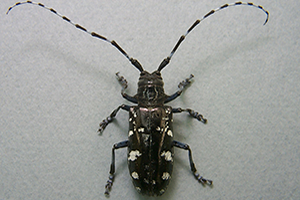Photo Credit: Donald Duerr, USDA Forest Service, Bugwood.org. Creative Commons Attribution 3.0 United States (CC BY 3.0 US) License; https://creativecommons.org/licenses/by/3.0/us/.
Anoplophora glabripennis
Common Name: Asian longhorned beetle
Animal Guild: Insect
Class > Order > Family: Insecta > Coleoptera > Cerambycidae
Where is the species found?
States & Provinces
MA, NY, OH, SC
Special Considerations for Observing
Asian longhorned beetles are invasive pests that cause tree mortality and pose a serious threat to eastern forests. If you see an Asian longhorned beetle please report it immediately to USDA APHIS.
Which phenophases should I observe?
Do you see/hear...?
Activity
Adults More...
For abundance, enter the number of individual animals observed in this phenophase.
Adults feeding Anoplophora glabripennis , adults feed on the leaves and twigs of trees.
For abundance, enter the number of individual animals observed in this phenophase.
Reproduction
Mating For abundance, enter the number of individual animals observed in this phenophase.
Egg laying Anoplophora glabripennis , eggs are deposited inside holes the female has chewed in the bark of a tree.
For abundance, enter the number of individual animals observed in this phenophase.
Development
Dead adults For abundance, enter the number of individual animals observed in this phenophase.
Method
Individuals in a net For abundance, enter the number of individual animals observed in this phenophase.
Individuals in a trap For abundance, enter the number of individual animals observed in this phenophase.
What do these phenophases look like?
The following Phenophase Photo Guides for this species have been vetted for accuracy by the USA-NPN National Coordinating Office. Most photo guides are developed for a particular local or regional monitoring effort, and some of the content may not apply to your effort or your region. However, we make them available to provide as much help as they may in illustrating phenophases for this species. If you have high quality phenophase photos that you are willing to share with us, please visit the Phenophase Photo Guidelines page.
Be aware there is variation from individual to individual within a species, especially across different regions, so your plant may not look exactly like the one pictured.
Since they do not always include complete definitions for the species, use these photo guides ONLY in conjunction with the official Nature's Notebook phenophase defintions included in the table above, in the phenophase definition sheet that downloads with the datasheet, or in the Observe screen in the mobile app.
